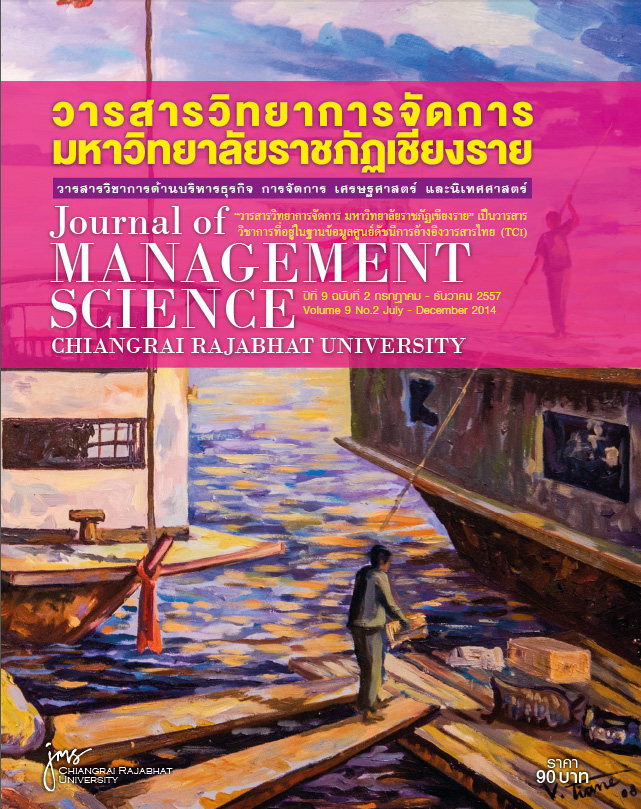Learning Achievement through Interactive Multimedia with different narration techniques of Higher Education Students, Chiang Mai
Main Article Content
Abstract
This research was conducted to compare learning effectiveness on knowledge, attitude and skill domains between learning through interactive multimedia of higher education students. Data was collected from randomization of 3 groups, 50 students each. The first group was learned through interactive multimedia with normal narration storytelling technique whereas the second group was learned through interactive multimedia with narration corporated with professional photographers’ interview, the third group was learned through interactive multimedia narrated with professional photographers’ interview only. The research found that the knowledge and the skill increased scores of the groups of student learning through interactive multimedia with narration and professional photographers’ interview were higher than the other two groups, with statistically significant level at .01 and .05 respectively. Most students who exposed learning through interactive multimedia provided good attitude on perception, positive responses and appreciated in value of learning content and interactive media quality.
Article Details
Views and opinions expressed in the journal do not necessarily reflect those of the editors.
References
.ปัณฑิตา บุญญฤทธิ์.(2550).การรับชมรายการสารคดีโทรทัศน์ของชาวกรุงเทพมหานคร.วิทยานิพนธ์ปริญญาศิลปศาสตรมหาบัณฑิต สาขาเทคโนโลยีสื่่อสารมวลชน,มหาวิทยาลัยรามคำแหง.รจิตลักษณ์ แสงอุไร. (2548).การสื่อสารของมนุษย์.กรุงเทพฯ: 21 เซ็นจูรี่.วิทยา ดำรงเกียรติศักดิ์. (2541). แนวความคิดและวิธีการสื่อสารการเกษตร (พิมพ์ครั้งที่10). เชียงใหม่: มหาวิทยาลัยแม่โจ้.___________________.(2542). สรุปทฤษฎีการสื่อสาร. เชียงใหม่: มหาวิทยาลัยแม่โจ้.___________________.(2553). การเรียนรู้ผ่านมัลติมีเดีย . สืบค้น 15 ตุลาคม 2553, จาก
http://www.infocommmju.com/icarticle/images/stories/icarticles/ajwittaya/Multimedia_learning.pdf.___________________.(2554). การเชื่อใจ ความศรัทธาในการสื่อสาร และการพัฒนาปัญญา. สืบค้น 13ธันวาคม 2554,จากhttp://www.infocommmju.com/icarticle/
images/stories/icarticles/ajwittaya/trust_communication1.pdf.__________________.(2555). การผลิตและสร้างสรรค์สารคดีโทรทัศน์. สืบค้น 15 มีนาคม 2555 , จาก http://www.infocommmju.com/icarticle/images/stories/icarticles/ajwittaya/documentary_production-1.pdf. เอกวิทย์ แกวประดิษฐ์. ้ (2545). เทคโนโลยีการศึกษา:หลักการและแนวคิดสู่การปฏิบัติ .สงขลา: มหาวิทยาลัยทักษิณ.สถาบันส่งเสริมอัจฉริยภาพและนวัตกรรมการเรียนรู้. (2551). หลักการเรียนรู้ของสมอง ตามแนวคิด BBL. สืบค้น 23 เมษายน 2551, จาก http://www.igil.or.th/th/bbl-resources/what-is-bbl/basic-bbl-principles.htm lสมประสงค์ เสนารัตน์. (2554).กระบวนการทางการศึกษาและจุดม่งหมายทางการศึกษา ุด้านพทธิพิสัย ุ . สืบค้น 13 ธันวาคม 2554, จากhttp://images.senarat.multiply.multiplycontent.com/attachment/0/TWuBzAooCGwAAG3S0B01/bloom_revised.pdf?key=senarat:journal:100&nmid=418821494 Anderson, L W, and Krathwohl D R. (2001). A Taxonomy for Learning, Teaching,
and Assessing: A Revision of Bloom's Taxonomy of Educational Objectives. Longman: New York. Berk, R.A. (2009).Multimedia teaching with video clips: TV, movies, YouTube, and mtvU in the college classroom. InternationalJournalof Technologyin Teaching
and Learning. Bloom, B. S., Englehart, M. B., Furst, E. J., Hill, W. H., & Krathwohl, D. R. (1956). Taxonomy of educational objectives: Handbook on I: Cognitive Domain. New York: David MCkay. DevittPG,Plamer E. (1999). Computer-aided learning: An overvalued educational resource? Med. Educ. Dwyer , F.M. 1978. Strategies For Inproving Visualized Learning. State College LearningServices. Fisher,Walter R. (1987). Human Communication as Narration: toward a Philosophy of Reason, Value and Action. Columbia: University ofSouth Carolina. Gazzaniga, M.S. (1992). Nature’s Mind. NY: Basic Books. Goleman, D. (1998). Working with emotional intelligence. NY: Bantam Books. Hadley J, Kulier R, Zamora J, Coppus SF, Weinbrenner S, et al. (2010). Effectiveness
of an e-learning course in evidence-based medicine for foundation (internship) training. J R Soc Med. Hebert,S.,&Peretz, I. (1997).Recognition of music in long-term memory: Are melodic and temporal patterns equal partners? Memory and Cognition.
HudsonJN. (2004). Computer-aided learning in the real world of medical education:Does the quality of interaction with the computer affect student learning? Med. Educ. Karakas E, TekindalS. (2008). The effects of computer-assisted learning in teaching
permanent magnet synchronous motors. IEEE. Trans. Educ. Mayer, R.E. (2006). Ten Principles of Multimedia Learning. Retrieved March 15, 2014, from http://ericsnewblog.blogspot.com/ ___________________. (2014).12 Principles of Multimedia Learning. RetrievedMarch 15, 2014, from http://hartford.edu/academics/faculty/fcld/data/documentation/technology/presentation/powerpoint/12_principles_multimedia.pdf. Moneta, G.B. and Moneta,S.S. (2007). Affective Learning in online Multimedia and
Lecture Versions of an Introductory Computing Course. Educational Psychology, 27 (1),51-74. NazirM.J., Rizvi A.h.,and Pujeri R.V. (2012).Skill Development in Multimedia Based Learning Environment in Higher Education: An Operational Model. International Journal of Information and Communication Technology Research. 2 (11). North, A.C. & Hargreaves, D.J. (1997). Liking, arousal potential, and the emotional expressed by music.Scandinavian Journal ofPsychiatry. Renate Nummela Caine and Geoffrey Caine. 1992. 12 Principles for Brain-Based Learning. Retrieved December 13, 2011, from http://www.nea.org/eachexperience/braik030925.html. Selwyn. (2007). The use of computer technology in university teaching and learning: a critical perspective. J. Comp. Assist. Learn. Smart KL, Cappel JJ. (2006).Students perceptions of online learning: A comparative study. JTE. TheuriP.M., Greer B.M., Turner, L.D. (2011). The Efficacies of Utilizing a Multimedia, Based Instructional Supplement on Learners’ Cognitive Skills. The
Accounting Educators’ Journal, (21),107-129. Waterhouse, L. (2006a).Inadequate evidence for multiple intelligences, Mozart effect, and emotional intelligence theories. EducationalPsychologist. ___________________. (2006b). Multiple intelligences, the Mozart effect, and emotional intelligences: A critical review. EducationalPsychologist. WoffordMM,Spickard AW,WoffordJL. (2001). The computer-based lecture. J. Gen. Int. Med.


